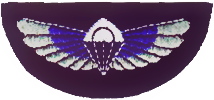5th Special Air Service
| 5th Special Air Service | |
|---|---|
Lili Marlene | |
| Battle honours | Normandy – Belgium – Ardennes – Emden – Oldenburg Fourragère of the Leopold Order Fourragère of the French Croix de Guerre 1939–1945 |
| Commanders | |
| Notable commanders | Lieutenant Colonel Eddy Blondeel |
The 5th Special Air Service (5th SAS) was an elite
History
A Belgian Independent Parachute Company was officially founded at Malvern Wells (Worcestershire) on 8 May 1942 by Henri Rolin, the then-Belgian undersecretary for defense. It comprised the following:
- A Company, 2nd Battalion Belgian Fusiliers, a Battalion mainly made up of Belgian volunteers from South and North America organised after January 1941, who moved to Great Britain in June 1941. A Company as a whole volunteered in February 1942 to train as an Independent Parachute Company under Lt. Freddy Limbosch as Chief Instructor.
- A platoon of the 1st Battalion Belgian Fusiliers with some qualified parachutists (since January 1942).
- Volunteers from other Belgian Forces units who had escaped occupied Belgium via France, Spain and Gibraltar.
The newly formed Company continued to train as an Independent Parachute Company, making extensive use of the schools and training facilities offered by the British (the first
The unit was attached for 3 months to the 8th Parachute Battalion of the 6th Airborne Division in 1943, then spent a month in intensive training in December 1943 at the Allied Training Centre Inverlochy Castle (Fort William), and finally in February 1944, at Loudon Castle Camp, near Galston (Ayrshire) joining the Special Air Service (S.A.S.) Brigade.[3]
Like all military units and formations the men came from all walks of life. The volunteers included a former world cycling champion, lawyers, farmers, labourers, lumberjacks, a circus acrobat, a professional wrestler and three

The role of the Belgian SAS parachutists during the Second World War was primarily
In the beginning of April 1945 the Belgian SAS Squadron consisted of three reconnaissance squads that deployed in the north of the Netherlands and in Germany. After the capitulation of the Germans on 8 May 1945 the Belgian SAS participated in 'Counter Intelligence' missions in both (Germany) and Denmark.
At the end of the war the Belgian SAS Regiment were the first Allied unit to set foot in Belgium and Germany and the only Belgian unit permanently on active deployment between July 1944 and May 1945. They were responsible for the capture of
Insignia

- The Commanding Officer David Stirling, with the proposed wording 'Descend to Defend' or 'Strike and Destroy' disallowed. The sword depicted is the Sword of Damocles[6]
- The Maroon beret.
- The SAS pattern parachute wings were designed by Lieutenant Jock Lewes and based on the basic British Army design approved in 1940, but modified to reflect the Middle East origins of the new unit by the substitution of the stylised sacred ibis wings of Isis of Egyptian iconography depicted in the décor of Shepheard's Hotelin Cairo.
Disbandment
On 21 September 1945 5th SAS was transferred from the
Amid defense cuts and reorganization to the Belgian army, in 2011 1 PARA was disbanded after 59 years of continuous service. In December 2010 the unit's banner, flag and insignia were officially handed over to the newly formed Special Forces Group (SFG).
The last veteran of 5th Special Air Service was Jaak Daemen from Leopoldsburg who died in August 2022, aged 97.[8]
See also
References
- ^ Genot, E. (1986). Rode mutsen, Groene mutsen [Red Berets, Green Berets] (in Dutch). Kraainem: E. Genot. [page needed]
- ^ "Belgian SAS". WWII Forums. Retrieved 21 September 2019.
- ^ "History". BelgianSAS.com. Archived from the original on 14 November 2010. Retrieved 4 December 2009.
- ^ "Operations". BelgianSAS.com. Archived from the original on 2 February 2008.
- ISBN 978-0-09-190182-0. [page needed]
- ^ "Special Air Service (SAS) cap badge". Imperial War Museums.
- ^ "1ste Bataljon Parachutisten". 1para.be (in Dutch).
- ^ Rankin, Jennifer (12 August 2022). "Last Veteran of Belgian SAS Dies aged 97". The Guardian. Retrieved 17 August 2022.
Bibliography
- Thomas, Nigel (1991). Foreign Volunteers of the Allied Forces, 1939–45. London: Osprey. ISBN 1-85532-136-X.
- Regner, Jules; Lefèvre, André; De Pierpont, Guy (1977). De geschiedenis van de Belgische regimenten parachutisten -- S.A.S. commando's en para-commando's. Brussels: G.O. & C. OCLC 71734205.
